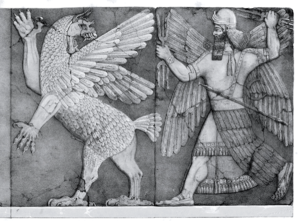Tiamat
In Babylonian mythology, Tiamat is the female principle of chaos (represented as the anarchic, tumultuous sea or the powers of salt water) which takes the form of a dragon. She is depicted as the enemy of the gods of light and law.

The Babylonian creation epic
As the story is told in the Babylonian Epic of the Creation, Tiamat and her husband, Aspu (the primeval father, a personification of the ocean, the Deep, the powers of the fresh waters), were in existence along with their son, Mummu, before the heavens and earth were created. After a succession of generations of gods came forth from Aspu and Tiamat, Aspu, angered by these turbulent and boisterous beings who were disturbing his former peace, resolved to be rid of the new gods. One of these, Ea, learned of this and destroyed Aspu before he could implement his plans.
The vengeful Tiamat thus became the formidable enemy of the new gods, until she and the forces of chaos (including enormous dragons and serpents which she created as her allies) were at last overcome by Marduk, the great god of Babylon, who then fashioned the heavens and the earth and organized the universe. In another variation of the creation legend, Tiamat represents the subterranean waters of chaos, the elementary principle from which the earth arose in the form of a mountain.
Zechariah Sitchin’s theories
Zecharia Sitchin interprets the creation myth as a tale of the creation of our solar system: In the beginning before the formation of the other planets, there was only Aspu (the Sun), Mummu (Mercury), and Tiamat. Tiamat (the “missing planet”) was later split in half when it collided with the satellites of Marduk, a large planet drawn into this solar system by the gravitational pull of Neptune. Tiamat’s upper half, along with her chief satellite, became Earth and her moon; her lower half, shattered by Marduk during its second orbit, became the asteroid belt between Mars and Jupiter.
Sitchin suggests that in this series of events Marduk transferred the seed of life to Earth, giving her “the biological and complex early forms of life for whose early appearance there is no other explanation.” He says that at the time the human species on Earth was just beginning to stir, Marduk had already evolved into a planet with high levels of civilization and technology.
According to Sitchin, Marduk is caught in a large elliptical orbit around the Sun and returns to the site of the collision between Jupiter and Mars every 3,600 Earth-years. He calls Marduk “the Twelfth Planet” after the ancient Sumerians’ scheme of this solar system, which depicts 12 celestial bodies—the Sun, the moon, and 10 planets.
For more information
See the following works by Zecharia Sitchin: The 12th Planet (New York: Avon Books, 1976), pp. 204, 210–34, 255–56; The Stairway to Heaven (New York: St. Martin’s Press, 1980), pp. 88–90.
Sources
Mark L. Prophet and Elizabeth Clare Prophet, Lost Teachings on Your Higher Self, pp. 284–86.
